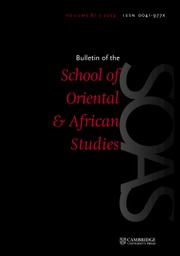The book under review represents a pioneering study of the Hittite pronominal system undertaken from the functionalist perspective. Not so long ago it was firmly believed that Hittite featured an opposition between the two basic demonstrative pronouns kā- ‘this’ and apā- ‘that’, plus a number of peripheral demonstratives with unclear functions (see e.g. S. Luraghi, Hittite, Munich 1997, 25–6). The starting point for the revision of this view was the long-neglected insight that the pronouns e-, aši-, eni- and uni- can be brought together in one paradigm in the majority of Hittite texts (E. Laroche, “Anaphore et deixis en anatolien”, Hethitisch und Indogermanisch, E. Neu and W. Meid (eds), Innsbruck, 1979, 147–52). In diachronic terms, the new deictic pronoun represents a cognate of the well-known Hittite clitic anaphor -a-, but its direct case forms acquired the i-extension, e.g. nom. sg. c a-š-i. Although less frequent than the forms of kā- and apā-, the members of the new paradigm are so numerous that they could no longer be relegated to the periphery of the Hittite grammatical system.
The existence of a triple opposition among Hittite demonstratives obviously required functional interpretation. Was it distance-oriented, as, for example, in Spanish, or person-oriented, as, say, in Latin? The answer to such a question can be difficult to find when one is dealing with an extinct limited-corpus language that precludes the possibility of running standard tests on informants. Goedegebuure had to develop her own methodology, selecting those genres and contexts in the Hittite corpus that are conducive to discriminating between the two options. The Hittite letters proved to be especially helpful for showing that the demonstrative pronoun apā- and its derivatives can specifically refer to the objects in the proximity of the addressee. The proximal kā- ‘this’ is obviously a natural candidate for the first person demonstrative, but one specific function that helps to corroborate this conjecture seems to be its systematic cataphoric use in lists (e.g. “This is his gift: 50 breads”). At the moment when a new entity is referred to but not yet defined, it remains familiar to the speaker alone.
The demonstrative pronoun aši+, originally translated as distal ‘yon’ in Goedegebuure's thesis, is now more accurately described as referring to the objects lying outside the immediate reach or cognitive sphere of either the speaker or the addressee. As such, it represents a suitable device for anaphoric use. Since the clitic personal pronoun -a- is likewise normally used in the anaphoric function, this distribution offers, in my opinion, a new argument for the genetic relationship between the two pronominal forms. A connotation occasionally conveyed by the anaphoric use of aši+ is the negative emotional attitude of the speaker. This is different from the situation in Latin, where the same connotation is reserved for the second person demonstrative iste “that one of yours”. This is perhaps why no reflexes of aši+ are attested in the Anatolian languages of the first millennium bc, whereas the Latin third person demonstrative ille represents a ubiquitous source of articles in the Romance languages.
The second part of Goedegebuure's monograph is devoted to the pragmatics of the stressed personal pronoun apā- ‘that (one)’. The current consensus on its use is limited to the recognition that it represents an “emphatic” counterpart of the clitic personal pronoun -a-. The only scholar to go a step further was J. Boley (IF 108: 163), who claimed that the free-standing apā- was used for discourse topics with marked emphasis. Goedegebuure takes issue with this hypothesis, convincingly arguing that the pragmatic function of apā- in “emphatic” contexts is that of the narrow focus. The discussion of pragmatic configurations is naturally impossible without relying on some theoretical framework, and so the author follows Knud Lambrecht's distinction between the predicate focus, argument focus, and sentence focus constructions, where the notion of argument focus is roughly equivalent to the narrow focus of other works. But the way to illustrate the author's point without engaging in any technicalities is the frequent co-occurrence of the “emphatic” apā- with focus particles, such as =pat ‘only’ (exclusive focus) and the geminating =a ‘also, even’ (inclusive focus).
The emerging system is admittedly rather complex. In contrast with the logically connected functions of aši+ and -a-, there is no obvious semantic link between the uses of apā- as second person demonstrative and narrow focus marker. I would see it as a reason why the demonstrative apā- becomes rare in New Hittite and completely disappears in the Late New Hittite period. As a result of this, the system of Hittite demonstrative becomes distance-based by the mid-thirteenth century bc, the proximal pronoun kā- ‘this’ contrasting with its distal counterpart aši+ ‘that’. A different development apparently took place in the history of the related Luwian language, where apā- was generalized as a distal demonstrative, while anna/i-, a likely Luwian counterpart of aši+, is only found as a loanword in Middle Hittite texts.
The book under review is clearly structured and user-friendly. Those instructing in Hittite will find it helpful for teaching issues related to deixis and discourse structure, while specialists in general pragmatics have gained a reliable reference tool on Hittite (although the lack of morphologically annotated Hittite examples will represent a bit of an obstacle for the latter group). Philologists can deploy it for a refined understanding of a number of Hittite passages, in particular, those belonging to the Hittite Laws. And from the perspective of an Indo-Europeanist, the person-based system of deixis reconstructed for Hittite emerges as functionally comparable to the situation in Latin and some Indo-Iranian languages (see e.g. N. Sims-Williams, “The triple system of deixis in Sogdian”, Transactions of the Philological Society 92/1, 41-53). This increases the likelihood that a similar system also existed once in Proto-Indo European.


